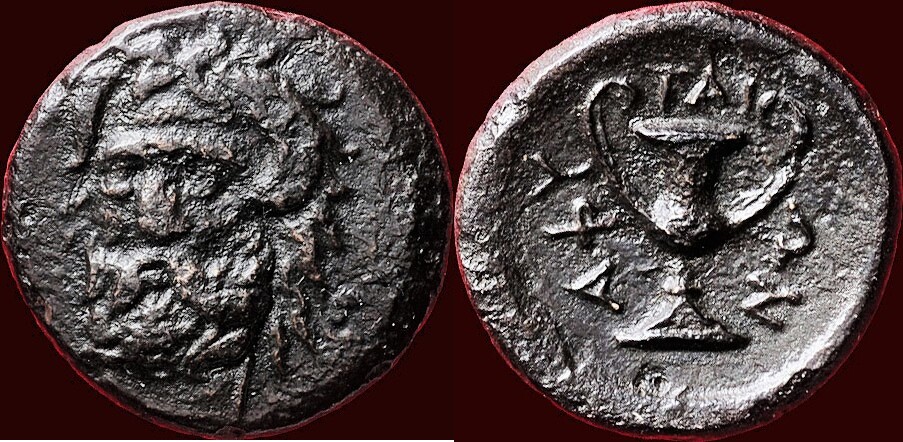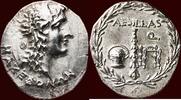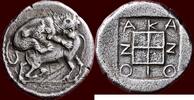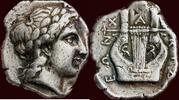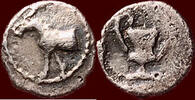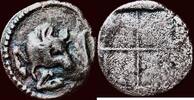MA-ID: 8480602010
Bewertungen Henzen
Schnelle Lieferung. Super Ware. Vielen Dank!
O.K.
perfekt !!!
Great coin, quick delivery, thanks!
400-348 BC v. Chr. MACEDONIA, APHYTIS - AE 19, circa 400-348 BC cf. CNG, Triton V sale, 15 Jan. 2002, lot 295 (in ss / vz : USD 3.600+ 15%)
Munthandel G.Henzen 

10
Seit 10 Jahren bei MA-Shops
7244 Bewertungen,
100 % Positiv (seit 24 Monaten)
Weltweiter Versand
3950,00 EUR
Differenzbesteuert nach §25a UStG
zzgl. 18,00 EUR Versand ( nach Deutschland )
Lieferzeit: 5 - 8 Tage*
zzgl. 18,00 EUR Versand ( nach Deutschland )
| Bestellhotline +49 (0)2871 2180 383 |
| Zahlungsarten |
| Überweisung |
cf. CNG, Triton V sale, 15 Jan. 2002, lot 295 (in ss / vz : USD 3.600+ 15%) | Abkürzungen
Temple of Dionysos
19,00 mm
weight 6,26gr. | bronze Ø 19mm.
obv. Head of Zeus-Ammon facing slightly left
rev. Kantharos, surrounded by the legend AΦY - TAI - ΩN Aphytis or Aphytos was an ancient Greek city in Pallene, the westernmost headland of Chalcidice. Around the middle of the 8th century BC colonists from Euboea arrived. The city became well known for its Temple of Dionysos, which appears to have been built in the second half of the 8th century BC. At Aphytis, Zeus-Ammon was worshipped, at least from the time of the Spartan general Lysander (ca. 403 BC), as zealously as in Ammonium, sanctuary in Libya. According to Pausanias, the patron of Aphytis, Zeus-Ammon, appeared in a dream to Lysander and urged him to raise the siege, which he did. The Temple of Zeus-Ammon, whose few remaining ruins date to the 4th century BC structure. During the Persian invasion of mainland Greece (480-479 BC), Aphytis contributed troops and ships to the already vast forces assembled by the Great King, Xerxes I. However, following their defeat and evacuation from Greece, the city soon became a member of the Athenian-led Delian League. This alliance was formed to defend against future Persian aggression, but quickly evolted into the basis for an Athenian empire. By 452/1 BC, Aphytis was paying tribute to Athens and it continued to do so until the end of the Peloponnesian War (431-404 BC) between Athens and Sparta. During archaic and classical times Aphytis was a prosperous city, minting its own coins, which depicted the head of its patron, Zeus-Ammon, the city′s economy appears to have been mainly based on farming and vine-culture. Aristotle (Politics V,VI 1319 a14) mentions the "agricultural law" of the Aphytians, a special, singular and interesting chapter in the history of ancient Greek public finances. The city became a member of the Chalkidian League it previously paid tribute under the Thracian phoros of the Delian League. During Hellenistic and Roman times the city minted coins again an event possibly related to the fame of the Temple of Zeus-Ammon. Strabo mentions Aphytis among the five cities, which existed in Pallene in the first century BC. (Kassandreia, Aphytis, Mende, Scione and Sane). After the founding of the Roman colony of Kassandreia (43 BC), Aphytis was a vicus of this colony, dependent administratively on it. The kantharos, depicted on this bronze coin, is related to the cult of Dionysos at Aphytis. The kantharos was a vessel for drinking wine. It is very likely that already in Greek times the city was an important centre of wine production
In the traditional village of Afytos in the modern Kassandra peninsula lie the organic, not irrigated vineyards and winery of the Papaefthymiou family, where native and worldwide famous grape varieties are cultivated, aiming in the production of low yield high quality wines.
cf. CNG, Triton V sale, 15 Jan. 2002, lot 295 (in vf/xf : USD 3.600 + 15%)
BMC 1 | Moushmov 6142 | SNG ANS 211 | SNG. Copenhagen 124
Laffaille 300 | AMNG III.2, p.45, nos.5-6 | Sear 1399 | HGC 3, 444 RR
Attractive dark patina. Beautiful sharp depiction of the kantharos.
A very rare historical coin.
vf/vf+
obv. Head of Zeus-Ammon facing slightly left
rev. Kantharos, surrounded by the legend AΦY - TAI - ΩN Aphytis or Aphytos was an ancient Greek city in Pallene, the westernmost headland of Chalcidice. Around the middle of the 8th century BC colonists from Euboea arrived. The city became well known for its Temple of Dionysos, which appears to have been built in the second half of the 8th century BC. At Aphytis, Zeus-Ammon was worshipped, at least from the time of the Spartan general Lysander (ca. 403 BC), as zealously as in Ammonium, sanctuary in Libya. According to Pausanias, the patron of Aphytis, Zeus-Ammon, appeared in a dream to Lysander and urged him to raise the siege, which he did. The Temple of Zeus-Ammon, whose few remaining ruins date to the 4th century BC structure. During the Persian invasion of mainland Greece (480-479 BC), Aphytis contributed troops and ships to the already vast forces assembled by the Great King, Xerxes I. However, following their defeat and evacuation from Greece, the city soon became a member of the Athenian-led Delian League. This alliance was formed to defend against future Persian aggression, but quickly evolted into the basis for an Athenian empire. By 452/1 BC, Aphytis was paying tribute to Athens and it continued to do so until the end of the Peloponnesian War (431-404 BC) between Athens and Sparta. During archaic and classical times Aphytis was a prosperous city, minting its own coins, which depicted the head of its patron, Zeus-Ammon, the city′s economy appears to have been mainly based on farming and vine-culture. Aristotle (Politics V,VI 1319 a14) mentions the "agricultural law" of the Aphytians, a special, singular and interesting chapter in the history of ancient Greek public finances. The city became a member of the Chalkidian League it previously paid tribute under the Thracian phoros of the Delian League. During Hellenistic and Roman times the city minted coins again an event possibly related to the fame of the Temple of Zeus-Ammon. Strabo mentions Aphytis among the five cities, which existed in Pallene in the first century BC. (Kassandreia, Aphytis, Mende, Scione and Sane). After the founding of the Roman colony of Kassandreia (43 BC), Aphytis was a vicus of this colony, dependent administratively on it. The kantharos, depicted on this bronze coin, is related to the cult of Dionysos at Aphytis. The kantharos was a vessel for drinking wine. It is very likely that already in Greek times the city was an important centre of wine production
In the traditional village of Afytos in the modern Kassandra peninsula lie the organic, not irrigated vineyards and winery of the Papaefthymiou family, where native and worldwide famous grape varieties are cultivated, aiming in the production of low yield high quality wines.
cf. CNG, Triton V sale, 15 Jan. 2002, lot 295 (in vf/xf : USD 3.600 + 15%)
BMC 1 | Moushmov 6142 | SNG ANS 211 | SNG. Copenhagen 124
Laffaille 300 | AMNG III.2, p.45, nos.5-6 | Sear 1399 | HGC 3, 444 RR
Attractive dark patina. Beautiful sharp depiction of the kantharos.
A very rare historical coin.
vf/vf+
Bitte beachten Sie unsere Mindestabnahme von 20 Euro. Sendungen nach China sind auf Gefahr des Käufers und nur Zahlung per banküberweisung. An PayPal und Kreditkarte Zahlungen sind immer Verwaltungs- und Risikokosten verbunden. Sendungen nach Russland, Ukraine und israel sind nicht möglich. Der Versand erfolgt innerhalb von 5 Tagen nach Zahlungseingang. BITTE KEIN PAYPAL ODER KREDITKARTE ZAHLUNGEN FÜR EU. Zahlen Sie bitte immer nur mit IBAN; schnell, billig und zuverlässich.
| Versandkosten | ||||
|---|---|---|---|---|
| bis 100,00 EUR | 100,00 EUR bis 500,00 EUR | 500,00 EUR bis 1000,00 EUR | über 1000,00 EUR | |
| Argentinien | 32,00 EUR | 32,00 EUR | 40,00 EUR | 40,00 EUR |
| Australien | 35,00 EUR | 35,00 EUR | 40,00 EUR | 40,00 EUR |
| Belgien | 9,50 EUR | 11,00 EUR | 13,00 EUR | 18,00 EUR |
| Brasilien | 55,00 EUR | 55,00 EUR | 55,00 EUR | 55,00 EUR |
| Bulgarien | 14,00 EUR | 16,00 EUR | 35,00 EUR | 45,00 EUR |
| Chile | 50,00 EUR | 50,00 EUR | 50,00 EUR | 50,00 EUR |
| China | 40,00 EUR | 40,00 EUR | 50,00 EUR | 50,00 EUR |
| Dänemark | 11,50 EUR | 13,00 EUR | 16,00 EUR | 20,00 EUR |
| Deutschland | 9,50 EUR | 11,00 EUR | 13,00 EUR | 18,00 EUR |
| Estland | 13,00 EUR | 14,00 EUR | 15,00 EUR | 25,00 EUR |
| Frankreich | 9,50 EUR | 11,00 EUR | 16,00 EUR | 25,00 EUR |
| Griechenland | 15,00 EUR | 25,00 EUR | 30,00 EUR | 35,00 EUR |
| Großbritannien | 25,00 EUR | 25,00 EUR | 26,00 EUR | 28,00 EUR |
| Hong Kong | 40,00 EUR | 40,00 EUR | 50,00 EUR | 50,00 EUR |
| Indien | 35,00 EUR | 35,00 EUR | 40,00 EUR | 50,00 EUR |
| Indonesien | 35,00 EUR | 35,00 EUR | 40,00 EUR | 40,00 EUR |
| Israel | 200,00 EUR | 200,00 EUR | 200,00 EUR | 200,00 EUR |
| Japan | 40,00 EUR | 40,00 EUR | 40,00 EUR | 40,00 EUR |
| Kambodscha | 65,00 EUR | 65,00 EUR | 65,00 EUR | 65,00 EUR |
| Kanada | 30,00 EUR | 30,00 EUR | 35,00 EUR | 35,00 EUR |
| Liechtenstein | 20,00 EUR | 20,00 EUR | 25,00 EUR | 25,00 EUR |
| Luxemburg | 11,00 EUR | 13,00 EUR | 16,00 EUR | 25,00 EUR |
| Malaysia | 35,00 EUR | 35,00 EUR | 40,00 EUR | 45,00 EUR |
| Niederlande | 8,50 EUR | 8,50 EUR | 11,00 EUR | 14,00 EUR |
| Norwegen | 25,00 EUR | 25,00 EUR | 30,00 EUR | 35,00 EUR |
| Österreich | 11,50 EUR | 12,50 EUR | 15,00 EUR | 25,00 EUR |
| Polen | 13,00 EUR | 14,00 EUR | 16,50 EUR | 25,00 EUR |
| Portugal | 13,00 EUR | 14,00 EUR | 18,00 EUR | 25,00 EUR |
| Rumänien | 16,00 EUR | 18,00 EUR | 25,00 EUR | 35,00 EUR |
| Russische Föderation | 200,00 EUR | 200,00 EUR | 200,00 EUR | 200,00 EUR |
| Schweiz | 30,00 EUR | 30,00 EUR | 40,00 EUR | 40,00 EUR |
| Serbien | 25,00 EUR | 25,00 EUR | 30,00 EUR | 35,00 EUR |
| Singapur | 35,00 EUR | 35,00 EUR | 35,00 EUR | 40,00 EUR |
| Slowakei | 13,00 EUR | 15,00 EUR | 20,00 EUR | 25,00 EUR |
| Spanien | 11,50 EUR | 13,50 EUR | 16,50 EUR | 25,00 EUR |
| Sri Lanka | 35,00 EUR | 35,00 EUR | 40,00 EUR | 45,00 EUR |
| Tschechische Republik | 12,00 EUR | 14,00 EUR | 18,00 EUR | 25,00 EUR |
| Ukraine | 200,00 EUR | 200,00 EUR | 200,00 EUR | 200,00 EUR |
| Ungarn | 14,00 EUR | 16,00 EUR | 25,00 EUR | 30,00 EUR |
| Vereinigte Staaten von Amerika | 32,00 EUR | 32,00 EUR | 35,00 EUR | 40,00 EUR |
| Europäische Union | 15,00 EUR | 17,00 EUR | 25,00 EUR | 30,00 EUR |
| Welt | 40,00 EUR | 40,00 EUR | 50,00 EUR | 50,00 EUR |
Informationen zum Kauf bei MA-Shops
Bestellungen bei MA-Shops sind jederzeit möglich und werden innerhalb von 2-4 Arbeitstagen verschickt.
Ein über die MA-Shops abgesicherter Kauf findet niemals außerhalb von MA-Shops statt.
Bestellen Sie sicher online mit dem MA-Shops Warenkorb.
Vielen Dank.
Ein über die MA-Shops abgesicherter Kauf findet niemals außerhalb von MA-Shops statt.
Bestellen Sie sicher online mit dem MA-Shops Warenkorb.
Vielen Dank.
|
Verkäufer-Startseite | 0Warenkorb | AGB | Impressum | MA AGB | Datenschutzerklärung | Garantie | MA-Shops Neuzugänge Copyright ® 2001-2025, MA-SHOPS Muenzen All Rights Reserved. Designated trademarks and brands are the property of their respective owners. |
 Münzen beim Fachhändler kaufen
Münzen beim Fachhändler kaufen


